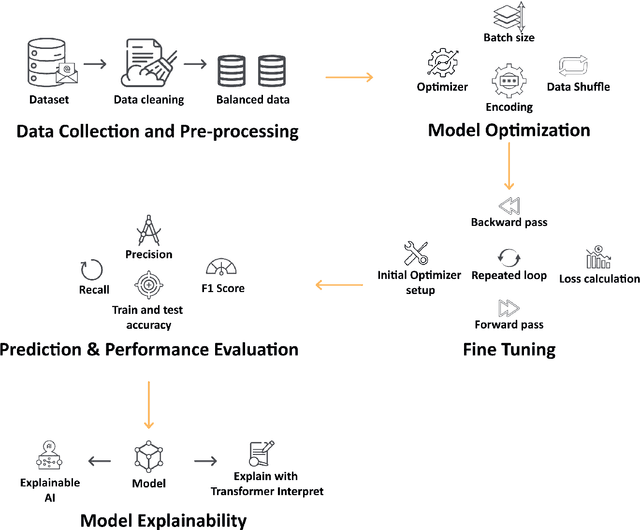Mohammad Amaz Uddin
ExplainableDetector: Exploring Transformer-based Language Modeling Approach for SMS Spam Detection with Explainability Analysis
May 12, 2024Abstract:SMS, or short messaging service, is a widely used and cost-effective communication medium that has sadly turned into a haven for unwanted messages, commonly known as SMS spam. With the rapid adoption of smartphones and Internet connectivity, SMS spam has emerged as a prevalent threat. Spammers have taken notice of the significance of SMS for mobile phone users. Consequently, with the emergence of new cybersecurity threats, the number of SMS spam has expanded significantly in recent years. The unstructured format of SMS data creates significant challenges for SMS spam detection, making it more difficult to successfully fight spam attacks in the cybersecurity domain. In this work, we employ optimized and fine-tuned transformer-based Large Language Models (LLMs) to solve the problem of spam message detection. We use a benchmark SMS spam dataset for this spam detection and utilize several preprocessing techniques to get clean and noise-free data and solve the class imbalance problem using the text augmentation technique. The overall experiment showed that our optimized fine-tuned BERT (Bidirectional Encoder Representations from Transformers) variant model RoBERTa obtained high accuracy with 99.84\%. We also work with Explainable Artificial Intelligence (XAI) techniques to calculate the positive and negative coefficient scores which explore and explain the fine-tuned model transparency in this text-based spam SMS detection task. In addition, traditional Machine Learning (ML) models were also examined to compare their performance with the transformer-based models. This analysis describes how LLMs can make a good impact on complex textual-based spam data in the cybersecurity field.
An Explainable Transformer-based Model for Phishing Email Detection: A Large Language Model Approach
Feb 21, 2024



Abstract:Phishing email is a serious cyber threat that tries to deceive users by sending false emails with the intention of stealing confidential information or causing financial harm. Attackers, often posing as trustworthy entities, exploit technological advancements and sophistication to make detection and prevention of phishing more challenging. Despite extensive academic research, phishing detection remains an ongoing and formidable challenge in the cybersecurity landscape. Large Language Models (LLMs) and Masked Language Models (MLMs) possess immense potential to offer innovative solutions to address long-standing challenges. In this research paper, we present an optimized, fine-tuned transformer-based DistilBERT model designed for the detection of phishing emails. In the detection process, we work with a phishing email dataset and utilize the preprocessing techniques to clean and solve the imbalance class issues. Through our experiments, we found that our model effectively achieves high accuracy, demonstrating its capability to perform well. Finally, we demonstrate our fine-tuned model using Explainable-AI (XAI) techniques such as Local Interpretable Model-Agnostic Explanations (LIME) and Transformer Interpret to explain how our model makes predictions in the context of text classification for phishing emails.
 Add to Chrome
Add to Chrome Add to Firefox
Add to Firefox Add to Edge
Add to Edge